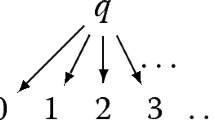Abstract
We look at substructural calculi from a game semantic point of view, guided by certain intuitions about resource conscious and, more specifically, cost conscious reasoning. To this aim, we start with a game, where player  defends a claim corresponding to a (single-conclusion) sequent, while player
defends a claim corresponding to a (single-conclusion) sequent, while player  tries to refute that claim. Branching rules for additive connectives are modeled by choices of
tries to refute that claim. Branching rules for additive connectives are modeled by choices of  , while branching for multiplicative connectives leads to splitting the game into parallel subgames, all of which have to be won by player
, while branching for multiplicative connectives leads to splitting the game into parallel subgames, all of which have to be won by player  to succeed. The game comes into full swing by adding cost labels to assumptions, and a corresponding budget. Different proofs of the same end-sequent are interpreted as more or less expensive strategies for
to succeed. The game comes into full swing by adding cost labels to assumptions, and a corresponding budget. Different proofs of the same end-sequent are interpreted as more or less expensive strategies for  to defend the corresponding claim. This leads to a new kind of labelled calculus, which can be seen as a fragment of
to defend the corresponding claim. This leads to a new kind of labelled calculus, which can be seen as a fragment of
 (subexponential linear logic). Finally, we generalize the concept of costs in proofs by using a semiring structure, illustrate our interpretation by examples and investigate some proof-theoretical properties.
(subexponential linear logic). Finally, we generalize the concept of costs in proofs by using a semiring structure, illustrate our interpretation by examples and investigate some proof-theoretical properties.
Olarte and Pimentel are funded by CNPq, CAPES and the project FWF START Y544-N23. Lang is supported by FWF project W1255-N23.
Access this chapter
Tax calculation will be finalised at checkout
Purchases are for personal use only
Similar content being viewed by others
References
Abramsky, S., Jagadeesan, R.: Games and full completeness for multiplicative linear logic. J. Symb. Log. 59(2), 543–574 (1994)
Accattoli, B., Graham-Lengrand, S., Kesner, D.: Tight typings and split bounds. PACMPL, 2(ICFP), 94:1–94:30 (2018)
Bistarelli, S., Gadducci, F.: Enhancing constraints manipulation in semiring-based formalisms. In: Brewka, G., Coradeschi, S., Perini, A., Traverso, P. (eds.) ECAI 2006, 17th European Conference on Artificial Intelligence, Including Prestigious Applications of Intelligent Systems (PAIS 2006), Proceedings. Frontiers in Artificial Intelligence and Applications, vol. 141, pp. 63–67. IOS Press (2006)
Bistarelli, S., Montanari, U., Rossi, F., Schiex, T., Verfaillie, G., Fargier, H.: Semiring-based CSPs and valued CSPs: frameworks, properties, and comparison. Constraints 4(3), 199–240 (1999)
Blass, A.: A game semantics for linear logic. Ann. Pure Appl. Logic 56(1–3), 183–220 (1992)
Blass, A.: Some semantical aspects of linear logic. Log. J. IGPL 5(4), 487–503 (1997)
Danos, V., Joinet, J.-B., Schellinx, H.: The structure of exponentials: uncovering the dynamics of linear logic proofs. In: Gottlob, G., Leitsch, A., Mundici, D. (eds.) KGC 1993. LNCS, vol. 713, pp. 159–171. Springer, Heidelberg (1993). https://doi.org/10.1007/BFb0022564
Delande, O., Miller, D., Saurin, A.: Proof and refutation in MALL as a game. Ann. Pure Appl. Logic 161(5), 654–672 (2010)
Deng, Y., Simmons, R.J., Cervesato, I.: Relating reasoning methodologies in linear logic and process algebra. Math. Struct. Comput. Sci. 26(5), 868–906 (2016)
Fermüller, C.G., Lang, T.: Interpreting sequent calculi as client-server games. In: Schmidt, R.A., Nalon, C. (eds.) TABLEAUX 2017. LNCS (LNAI), vol. 10501, pp. 98–113. Springer, Cham (2017). https://doi.org/10.1007/978-3-319-66902-1_6
Girard, J.-Y.: Linear logic. Theor. Comput. Sci. 50, 1–102 (1987)
Hyland, J.M.E., Ong, C.h.L.: Fair games and full completeness for multiplicative linear logic without the mix-rule (1993)
Japaridze, G.: A constructive game semantics for the language of linear logic. Ann. Pure Appl. Logic 85(2), 87–156 (1997)
Lamarche, F.: Games semantics for full propositional linear logic. In: Proceedings, 10th Annual IEEE Symposium on Logic in Computer Science, San Diego, California, USA, 26–29 June 1995, pp. 464–473. IEEE Computer Society (1995)
Lang, T., Olarte, C., Pimentel, E., Fermüller, C.: A Game Model for Proofs with Costs. arXiv e-prints, arXiv:1906.11742, June 2019
Lorenzen, P.: Logik und agon. Atti Del XII Congresso Internazionale di Filosofia 4, 187–194 (1960)
Melliès, P.-A.: Asynchronous games 4: a fully complete model of propositional linear logic. In: Proceedings of the 20th IEEE Symposium on Logic in Computer Science (LICS 2005), Chicago, IL, USA, 26–29 June 2005, pp. 386–395. IEEE Computer Society (2005)
Miller, D.: The \({\uppi }\)-calculus as a theory in linear logic: preliminary results. In: Lamma, E., Mello, P. (eds.) ELP 1992. LNCS, vol. 660, pp. 242–264. Springer, Heidelberg (1993). https://doi.org/10.1007/3-540-56454-3_13
Nigam, V., Miller, D.: Algorithmic specifications in linear logic with subexponentials. In: Porto, A., López-Fraguas, F.J. (eds.) PPDP, pp. 129–140. ACM (2009)
Dutilh Novaes, C., French, R.: Paradoxes and structural rules from a dialogue perspective. Philos. Issues 28, 129–158 (2018)
Pimentel, E., Olarte, C., Nigam, V.: A proof theoretic study of soft concurrent constraint programming. TPLP 14(4–5), 649–663 (2014)
Straßburger, L.: MELL in the calculus of structures. Theor. Comput. Sci. 309(1–3), 213–285 (2003)
Straßburger, L., Guglielmi, A.: A system of interaction and structure IV: the exponentials and decomposition. ACM Trans. Comput. Log. 12(4), 23:1–23:39 (2011)
Author information
Authors and Affiliations
Corresponding author
Editor information
Editors and Affiliations
Rights and permissions
Copyright information
© 2019 Springer Nature Switzerland AG
About this paper
Cite this paper
Lang, T., Olarte, C., Pimentel, E., Fermüller, C.G. (2019). A Game Model for Proofs with Costs. In: Cerrito, S., Popescu, A. (eds) Automated Reasoning with Analytic Tableaux and Related Methods. TABLEAUX 2019. Lecture Notes in Computer Science(), vol 11714. Springer, Cham. https://doi.org/10.1007/978-3-030-29026-9_14
Download citation
DOI: https://doi.org/10.1007/978-3-030-29026-9_14
Published:
Publisher Name: Springer, Cham
Print ISBN: 978-3-030-29025-2
Online ISBN: 978-3-030-29026-9
eBook Packages: Computer ScienceComputer Science (R0)




